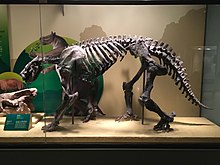| Barylambda | |
|---|---|

| |
| B. faberi skeleton, Field Museum | |
| Scientific classification | |
| Domain: | Eukaryota |
| Kingdom: | Animalia |
| Phylum: | Chordata |
| Class: | Mammalia |
| Order: | †Pantodonta |
| Family: | †Barylambdidae |
| Genus: | †Barylambda Patterson 1937 |
| Species[1] | |
| |
Barylambda (Greek: "heavy" (baros), "lambda" (lambda) in a reference to larger size than that of Pantolambda[2]) is an extinct genus of pantodont mammal from the middle to late Paleocene, well known from several finds in the Wasatchian (NALMA classification) DeBeque Formation of Colorado and the Clarkforkian Wasatch Formation to Tiffanian Fort Union Formation in Wyoming. Three species of Barylambda are currently recognized.[3] The creature likely lived a life similar to that of a modern tapir, browsing on foliage and soft vegetation.[4] Barylambda seems to have been quite successful for an early pantodont, though eventually it seems to have been replaced in its ecosystem by other pantodonts, such as Coryphodon.
- ^ "Pantodonta". After McKenna & Bell (1997) and Alroy (2002). Retrieved 2 November 2013.
- ^ "Glossary. American Museum of Natural History". Archived from the original on 20 November 2021.
- ^ Gingerich, Philip D.; Childress Jr, C.G (1983). "Barylambda churchilli, a new species of Pantolambdidae (Mammalia, Pantodonta) from the Late Paleocene of Western North America". Museum of Paleontology, the University of Michigan. hdl:2027.42/48516.
- ^ World Encyclopedia of Dinosaurs & Prehistoric Creatures: The Ultimate Visual Reference To 1000 Dinosaurs And Prehistoric Creatures Of Land, Air And Sea ... And Cretaceous Eras (World Encyclopedia) by Dougal Dixon